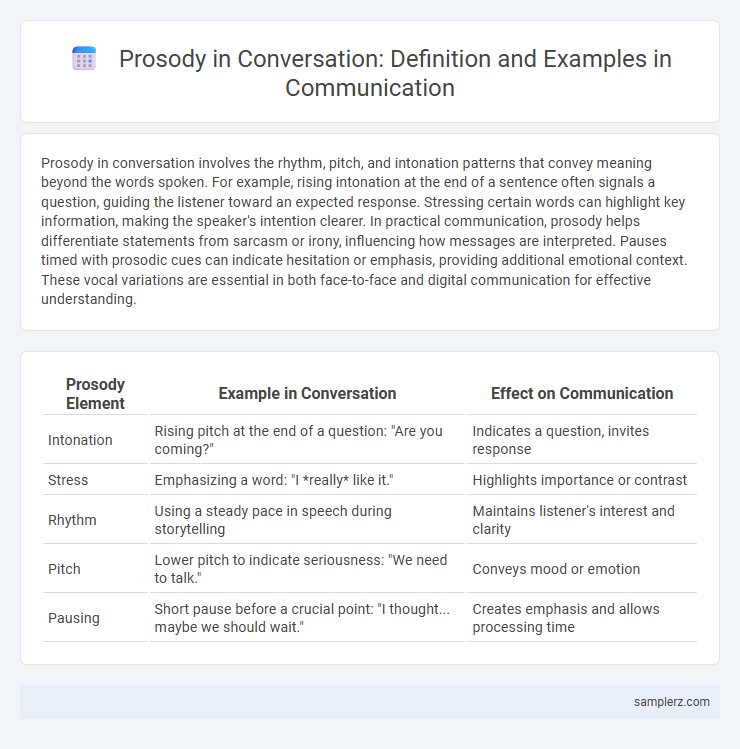Prosody in conversation involves the rhythm, pitch, and intonation patterns that convey meaning beyond the words spoken. For example, rising intonation at the end of a sentence often signals a question, guiding the listener toward an expected response. Stressing certain words can highlight key information, making the speaker's intention clearer. In practical communication, prosody helps differentiate statements from sarcasm or irony, influencing how messages are interpreted. Pauses timed with prosodic cues can indicate hesitation or emphasis, providing additional emotional context. These vocal variations are essential in both face-to-face and digital communication for effective understanding.
Table of Comparison
| Prosody Element | Example in Conversation | Effect on Communication |
|---|---|---|
| Intonation | Rising pitch at the end of a question: "Are you coming?" | Indicates a question, invites response |
| Stress | Emphasizing a word: "I *really* like it." | Highlights importance or contrast |
| Rhythm | Using a steady pace in speech during storytelling | Maintains listener's interest and clarity |
| Pitch | Lower pitch to indicate seriousness: "We need to talk." | Conveys mood or emotion |
| Pausing | Short pause before a crucial point: "I thought... maybe we should wait." | Creates emphasis and allows processing time |
Understanding Prosody in Everyday Conversations
Prosody in everyday conversations involves variations in pitch, rhythm, and intonation that convey emotions and emphasize meaning beyond words. For instance, rising intonation at the end of a question signals uncertainty or a request for confirmation, while a slower, softer tone can indicate sympathy or concern. Recognizing these prosodic cues enhances comprehension and helps interpret speakers' true intentions in dialogue.
Key Functions of Prosody in Spoken Interaction
Prosody in conversation enhances meaning by signaling emphasis, emotion, and speaker intent through variations in pitch, loudness, and tempo. It helps structure discourse by marking boundaries between phrases and indicating whether statements are questions or commands. These vocal cues facilitate listener comprehension and manage turn-taking during spoken interaction.
Examples of Intonation Shaping Meaning
Rising intonation at the end of a question signals inquiry or uncertainty, shaping the listener's expectation for a response. Falling intonation typically indicates statement completion or certainty, reinforcing the speaker's intent. Variations in pitch and stress can transform simple phrases, such as turning "You're coming" into a confirmation or a question depending on the intonation pattern used.
Stress Patterns That Alter Intent
Stress patterns in conversation significantly alter intent by emphasizing different words or syllables, which changes the meaning conveyed. For example, stressing "I" in the sentence "I didn't say you lied" implies the speaker is denying personal involvement, while stressing "lied" suggests questioning the truthfulness of a statement. These variations in prosody help listeners interpret emotions, sarcasm, or emphasis, enhancing the clarity and nuance of verbal communication.
Using Rhythm to Manage Conversational Flow
Using rhythm in conversation regulates turn-taking and emphasizes key points, enhancing overall communication effectiveness. Strategic pauses and variations in speech tempo signal when to listen or respond, maintaining smooth interaction flow. This prosodic feature reduces interruptions and clarifies speaker intent, fostering mutual understanding.
Pausing and Its Communicative Effects
Pausing in conversation serves as a powerful prosodic tool that enhances comprehension and emphasizes key points, allowing speakers to signal the end of thoughts or prepare listeners for important information. Strategic pauses can create suspense, indicate hesitation, or facilitate turn-taking between interlocutors, improving the overall flow of communication. Research in conversational analysis highlights that effective use of pausing correlates with increased listener engagement and clearer message delivery.
Prosodic Cues in Expressing Emotion
Prosodic cues such as pitch, intonation, and rhythm play a crucial role in expressing emotion during conversation, conveying feelings like happiness, anger, or sadness beyond the literal meaning of words. Variations in pitch can signal excitement or frustration, while changes in speech tempo highlight urgency or calmness. These vocal patterns enable listeners to interpret the speaker's emotional state accurately, enhancing interpersonal understanding.
Prosody’s Role in Signaling Questions and Statements
Prosody plays a crucial role in signaling questions and statements by modifying pitch, intonation, and rhythm during conversation. Rising intonation at the end of a sentence typically indicates a question, while falling intonation signals a statement or assertion. This auditory pattern helps listeners differentiate between inquiries and declarations, enhancing clarity and effective communication.
Clarifying Ambiguity Through Prosody
Rising intonation at the end of a sentence often signals a question, helping to clarify ambiguity in spoken communication. Stressing specific words can change the meaning of a phrase, guiding listeners to the intended interpretation. Variations in pitch and rhythm serve as prosodic cues that disambiguate phrases with multiple possible meanings.
Prosody Across Different Cultures in Conversation
Prosody in conversation varies significantly across cultures, influencing rhythm, pitch, and intonation to convey meaning and emotion uniquely. For example, East Asian languages like Japanese use pitch accent to distinguish word meaning, while tonal languages such as Mandarin rely heavily on pitch variation for lexical differences. These prosodic elements shape conversational dynamics and understanding in multicultural communication settings.

example of prosody in conversation Infographic
 samplerz.com
samplerz.com